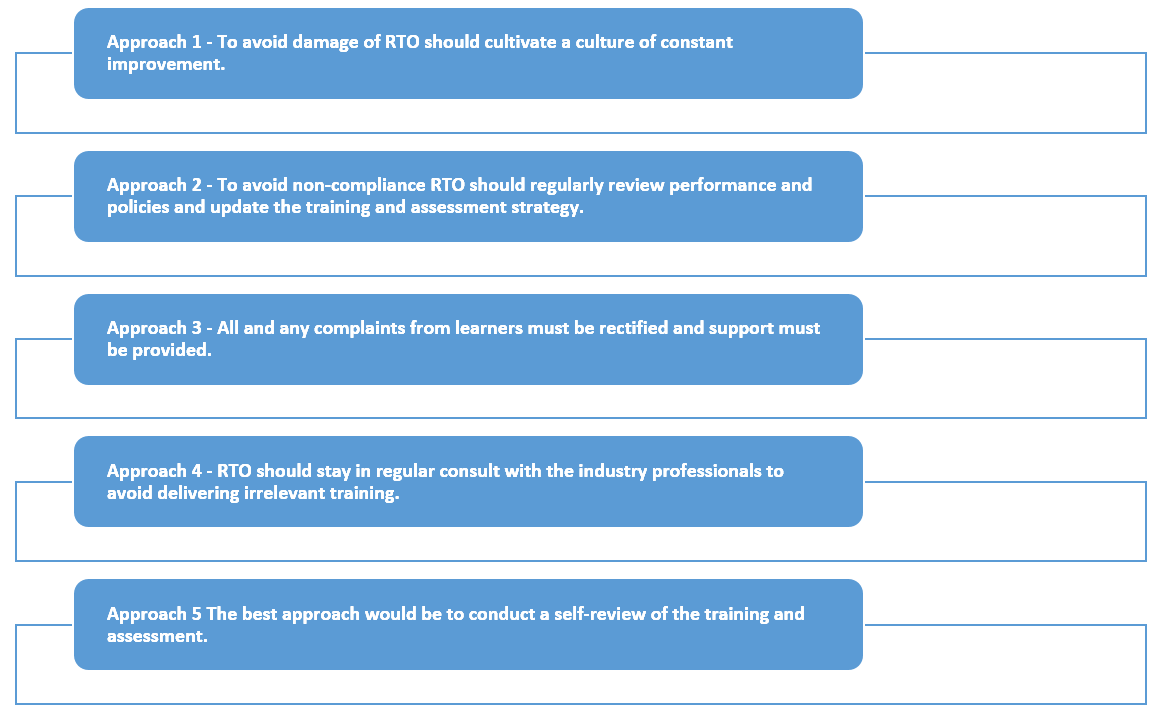Introduction
For Registered Training Organisations performance of the training and assessment marks their reputation. To maintain this reputation, they keep performing and delivering quality training and assessment. They also have to sustain their compliance with the Standards for RTO 2015 to stay operational in the VET sector.
This blog,” Why is it important for RTOs to regularly review their compliance and performance?” offers effective approaches to improve review performance and compliance with the RTO standards as well as the benefits to the VET industry. Let us begin.
What will happen if the RTO is non-compliant with the Standards for RTO 2015?
According to the ASQA’s approach to compliance version 1.1, the following outcomes can be expected with non-compliance with the Standards for RTOs for the training providers.
Outcome 1- RTO may face suspension of their registration.
ASQA may choose to suspend RTO’s registration and issue a timeline to correct the non-compliance. The operations during the suspension period will be on hold affecting learners and the Registered Training organisation’s staff as well as training and development.
Outcome 2- RTO may have to publicly come and issue a notice in a professional manner stating the non-compliance.
ASQA may ask the RTO to issue a public notice stating the non-compliance which will be available on RTO’s business website and other social media platforms the RTO uses.
Outcome 3- There might be instructions to take particular steps for operational compliance to correct the non-compliance.
In certain cases of non-compliance, Registered Training organisations might be issued directives to resolve the issue. RTO will be given a timeline to take action towards those directives.
Outcome 4- ASQA may take control of the RTO under specific circumstances.
Under ASQA’s guidance, the training organisation will be taken control of. The RTO will be asked to take corrective measures to resolve the issue of non-compliance leading to a bad reputation.
Outcome 5- RTO may face cancellation of their registration.
If the non-compliance is severe ASQA may end up cancelling RTO’s registration putting the entire training/assessing staff at risk of losing their jobs. The learners may have to switch RTOs facing damage to their job prospects. ASQA will also remove the particular RTO from the VET National Register leading to huge losses.
Outcome 6- ASQA may deny the authority to deliver certain qualifications or courses.
ASQA has the power to deny RTO to deliver the non-compliant course or units of competency of a particular training package. This may heavily affect the enrolled students and the trainers as well as the RTO quality.
Outcome 7- There may be a fine and penalty imposed by ASQA.
RTO may be heavily penalised for irregularities of non-compliance. This may cost a lot to pay the fine and penalties. The amount will vary according to the extent of non-compliance nonetheless damaging RTO finances.
Outcome 8- RTO might experience low training and assessment outcomes.
Non-compliance may lead to students exiting the training leading to low completion rates. This will impact on the growth of the RTO.
Outcome 9- RTO may take a hit to its reputation and lose the trust of the learners causing attendance issues.
Non-compliance with the standards will lead to low learner satisfaction and low completion rates. This will create further damage to the RTO’s reputation and create a negative and hard impact on the RTO and learners.
Outcome 10- RTO may be prosecuted for non-compliance costing funds in legal fees.
There is a possibility of being prosecuted by ASQA because of the non-compliance. Getting back on track may require huge legal fees with a time taking process affecting badly the RTO finances.
What are the approaches to improve review performance and compliance with the RTO standards?
 Approach 1 – To avoid damage of RTO should cultivate a culture of constant improvement.
Approach 1 – To avoid damage of RTO should cultivate a culture of constant improvement.
RTO should encourage the RTO staff and relevant stakeholders to better training and delivery. Through seminars and professional training, RTO should keep the staff updated. The RTO goals and targets should have timelines and a plan to achieve those targets.
Approach 2 – To avoid non-compliance RTO should regularly review performance and policies and update the training and assessment strategy.
RTO should deploy a policy of regular review. The review should happen according to a framework that aligns with the RTO standards. RTO should ensure the policy covers all operations related to training and assessment of the RTO.
Approach 3 – All and any complaints from learners must be rectified and support must be provided.
RTOs should take feedback from the learners and provide support to the learners. They should resolve any and all complaints that the students have. RTO should have an open line of communication for support services for the assistance of its students.
Approach 4 – RTO should stay in regular consult with the industry professionals to avoid delivering irrelevant training.
RTO should take regular consultations with the relevant industry experts and stakeholders. The feedback will help RTO to improve areas that need more focus across industry standards. It will help RTO to provide current training to the learners as well.
Approach 5 – The best approach would be to conduct a self-review of the training and assessment.
Self-assessments done regularly will help RTO performance immensely as well as compliance with the Standards for RTO 2015. This will also improve business and provide financial stability. This will build a reputation and students’ trust in the RTO.
What are the benefits of improving review performance and compliance with the RTO standards for the VET workforce?
- It boosts compliance with the Standards for RTO 2015. Review performance and compliance with the RTO standards will help RTO to identify the weak spots in the training and assessment leading to better outcomes for stakeholders.
- The RTO will experience a boost to reputation and the trust of the learners. With this boost to reputation, new learners will bring more business and growth for the RTO.
- The learning experience will become better increasing learner outcomes. The learning experience will encompass high completion rates, and satisfying learner needs and job prospects of the learners.
- The stakeholders of the training like learners, RTO and employers will be assured of the quality of the training. A constant review will create a benchmark for RTO compliance and lead to quality that is backed by reviews and compliance.
- Improving review performance and compliance with the RTO standards will help the RTO to have a professional advantage over the rest of the competitors. This advantage will also reflect RTO’s commitment to quality vocational education and being a part of the Australian community’s success.
- Improving review performance and compliance with the RTO standards will help the RTO save expenses that could have happened in case of fines, restrictions and penalties. It would bring new learners to them increasing revenue generation.
Conclusion
RTOs need reviews and compliance checks regularly to be better at the VET standards. The approaches and benefits mentioned in the blog will provide a road map to create a framework and guidelines to carry out reviews.
If you are an RTO looking to buy RTO resources that are current and industry relevant as well as align with the Standards for RTO 2015 then VET Resources is your partner. We also offer free consultations to RTOs. Click here for a free consultation and further information.
FAQs
Q.1. What are the Standards for RTO 2015?
A.1 According to the VET RTO standards, “The purpose of the Standards for Registered Training Organisations (RTOs) 2015 is to arrange the requirements that an organisation must meet in order to be an RTO; ensure that training products delivered by RTOs meet the requirements of training packages or VET accredited courses, and have integrity for employment and further study; and ensure RTOs operate ethically with due consideration of learners’ and enterprises’ needs.”
Q.2 What are RTO training resources?
A.2 To know about RTO training resources read our blog, “The Ultimate Toolbox: Exploring the Power of RTO Training Resources- https://vetresources.com.au/the-ultimate-toolbox-exploring-the-power-of-rto-training-resources/”
Q.3 How RTOs can stay compliant in assessment?
A.3 To know about compliance practices read the blog, “Stay Compliant: The Ultimate Guide to RTO Assessment Tools- https://vetresources.com.au/stay-compliant-the-ultimate-guide-to-rto-assessment-tools/”
Q.4 What is VET in Australia?
A.4 To know everything about VET and vocational competencies read the blog, ” Vocational Education and Training – All You Need to Know- https://vetresources.com.au/vocational-education-and-training-all-you-need-to-know/”
Disclaimer:
The information presented on the VET Resources blog is for general guidance only. While we strive for accuracy, we cannot guarantee the completeness or timeliness of the information. VET Resources is not responsible for any errors or omissions, or for the results obtained from the use of this information. Always consult a professional for advice tailored to your circumstances.








